You probably have a roll or two of it in your bathroom. You know, in that drawer in the vanity that has the old razor you haven’t used in months, the cord for a shaver that broke last year, several band-aids and various tubes of ointments (most likely half of them are expired). I’m talking about dental floss (Duh, didn’t you see the title).
Well, that roll of dental floss can be used for a lot more than getting that chunk of steak fat from between those two back molars. It actually has a lot of uses, and since a roll is so small you can stash one (or four) in your bug out bag for in case of emergencies.
Not only can dental floss can be an indispensable addition to your bug out bag (especially considering a 140 yd roll of mint waxed is only $1 at the Dollar general Stores), but keeping one in the car for emergencies can be a good idea as well.
Now the minty flavored part is irrelevant, but being waxed helps it stay dry and makes it easier for uses like stitching leather. I regularly use un-waxed dental floss to stitch leather, but I used un-waxed so it will take the dye.
When I dye the object I have made, and besides, I am going to rub beeswax on it when it’s finished anyway. But for use as an emergency string, I would opt for the waxed type because that makes it water proof.
So let’s look at some uses for dental floss in an emergency situation. Think of it as synthetic sinew, it can do everything sinew can do and so much more. The first thought that comes to mind is using dental floss as fishing line, and I have actually used it for that before when I was a kid and I successfully caught several bluegill with it.
But keep in mind that dental floss doesn’t have the stretch, or elasticity, of real fishing line, so a single strand may not be strong enough for bigger fish. But it will work in a pinch because you can braid it and make stronger line if need be.
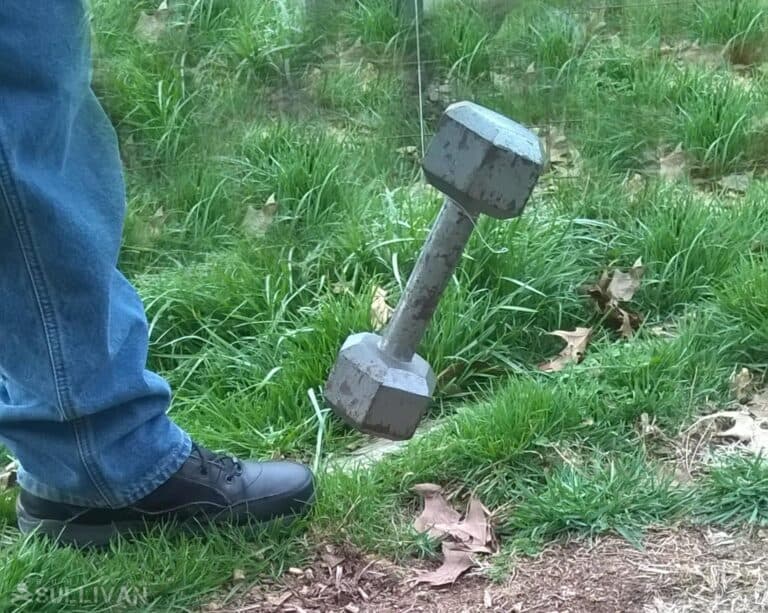
Tensile Strength
I tested a piece for this article just to get an idea of the tensile strength, and one single strand broke before it was able to lift a ten pound weight off the ground.
But when I doubled it, not braided or twisted or anything mind you, just two strands of floss, and then it was able to lift the ten pound weight off the ground. I lifted it several times to see if it would break but it held.
Let’s Do the Twist (or Braid)
Here is something interesting to note, when I tried to twist two strands of it together, like you do when twisting twine from fibers, it did NOT stay together. I’m not sure why, but it just wouldn’t hold the twist. However, when I braided three strands together it braided very nicely and held a tight braid.
I’m not sure of the physics behind it, but if one strand holds, let’s just say 5 pounds for the sake of easy math, when you twist or braid the same strands together it becomes exponentially stronger.
As in if one strand holds 5 pounds, three strands braided will hold maybe 20 pounds. I read a story about a convict using a 48 strand dental floss rope to escape and it succeeded in supporting a 155 pound man.
Braiding String
Keep in mind that braiding string as fine as dental floss is going to take some time to get any kind of length, but if you’re stranded or lost and need stronger than one strand (like for a bowstring), you have plenty of time to braid it.
To braid dental floss, (or any string really), tie the three loose ends together, and then tie that to a twig on a tree to hold it for you (like in the video showing me braiding floss, below).
If you have a lot to braid you may want to sit and do it rather than stand, in which case cut a stick from the tree and hold the stick with your feet while you braid.
Braiding is simple so if you’ve never done it have no fear. You have three strands, left, center, right, but that’s not the individual strands, it’s the position of the strands. Left, center, and right strings change their position constantly as you braid.
All you have to do is start from either side (let’s say left for the sake of the example), and go over the center, now that string you just moved becomes the center string.
Then you move the right string over the center string, now the right string is the center string. Then you just keep moving the left and right strings over the center string, pulling it tight as you go.
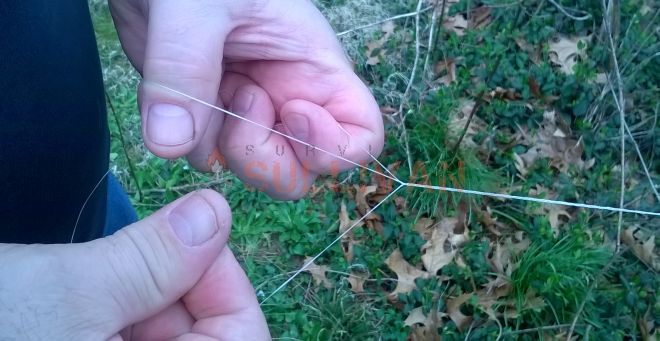
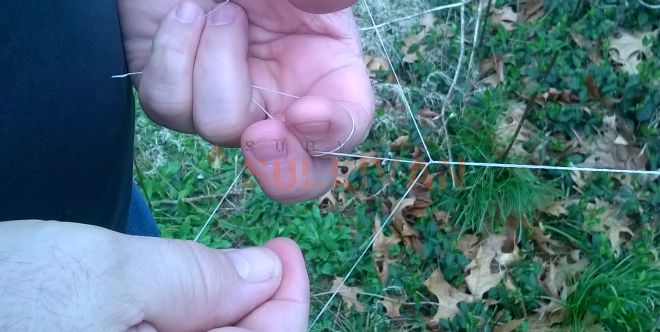
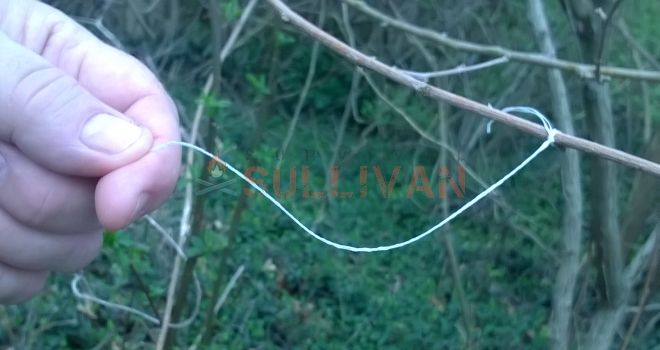
If you need a really heavy cord you can braid three smaller strands to make a thicker strand, then use those braided cords to braid again and make an even thicker cord. That will make a 9 strand braided cord, it would be pretty strong.
The same works with twisting cord too. With twisting cord you only use two strands, you twist them together to make a thicker strand, and then use two of those twisted strands to twist into an even thicker cord and so on.
Strong Little String
Dental floss is actually very strong considering how thin it is. I read a news story talking about how prisoners used dental floss to make garrotes to kill other prisoners with. One story told how some prisoners had collected about 18,000 feet of dental floss and braided it into ropes and escaped over the wall with it!
Dental floss is also supposed to have been used to cut through the bars of a cell to afford a prisoner’s escape. He used it with an abrasive material and painstakingly cut through the bars over an extended period of time.
Dental floss has basically become a problematic material in prisons and so subsequently it has been banned. Instead, prisoners are now only allowed “safety floss” loops or the little plastic sticks with a bit of floss on the end. There’s another story of an inmate escaping with a dental floss rope made from just 48 strands of floss.
Here’s a video discussing dental floss use in prisons:
Survival Uses for Floss
The following represent some time tested uses for floss in a survival situation. Sure, you might not have a call for every, single one of these when you are tested in the gravest extreme, but I’ll be willing to bet you hard-earned cash that you’ll have need for at least one or two of them.
Fishing line
Modern floss is remarkably strong and thin, making it perfect for improvised fishing line. To be clear, no, I would not advocate using it with your prized rod and reel as I would be willing to bet that it would foul up in pretty short order. But then again, I have never seen anybody test it, either!
Instead, utilize floss as fishing line with static lines or simple, improvised fishing rods. Especially if you are employing multiple static lines from a bank you’ll find that floss works just fine.
The tiny diameter, high tensile strength and delicate construction provides good feedback when you have a fish on the lot and so long as you are not trying to land a real monster you’ll find it is more than capable of bringing in fish worthy of dinner in a survival situation.
Stitching Leather
We know that floss makes a pretty dang good improvised thread or cordage, but what might we use this thread for?
One of the best tricks for using floss in ways that the manufacturers never intended is as a thread for stitching up leather. Leather is a unique material and that it is very tough while also remaining flexible and highly variable depending upon conditions
This, as you might imagine, can put a terrible strain on any thread and that is why you usually see leather sewn up or repaired with thicker stock.
However, the unique properties of floss, particularly its tensile strength but also its flexibility and innate resistance to wet environments makes it the perfect option for repairing or crafting with leather that might have to be used in a harsh environment.
Mending clothing
Another sewing task, floss is perfect for stitching up virtually any kind of clothing. In essence, floss works as a supple, flat thread or ribbon that is tough but yielding enough to stand up to the rigors of hard use. Perhaps the only limitation to using floss as thread for mending or reinforcing clothes is the skill of the user.
Simple, rough stitching will work well enough and quickly enough in a pinch to get you back underway with your clothing intact, but a thorough understanding of more intricate stitchery or stitchery for specialized repairs will see your floss perform out of all proportion with its price. I don’t know about you, but that sounds like a good incentive to learn sewing to me!
Shoe strings
Once again, where other threads or cordage fail or cannot be found your tiny roll of floss can get it done. Missing or broken shoe or boot laces can be a major showstopper and a survival situation, because if your footwear does not fit your foot correctly you’re going to have to travel slower with less protection while also enduring an increased risk of a slip, trip and fall. You cannot afford any of those outcomes when your life is on the line.
Not to worry, floss can save the day by standing in for your typical boot laces. Although smaller by an order of magnitude compared to typical laces, floss nonetheless has the strength while also maintaining a certain slippery quality to allow it to glide through eyelets and cleats.
You might need to double the floss or create thread from it as described above, but you’ll be able to depend on it at least in the short term.
Clothes line
Dental floss is the perfect sturdy line that can be used for hanging up clothing to dry in a pinch, with the added advantage that it won’t really care whatsoever if it gets wet, assuming you want to keep it, or you can just toss it because it is basically disposable anyway.
Ask anyone who has spent considerable time outdoors and they will tell you that keeping your clothing dry is your first action item if you want to prevent blisters and infections of the skin.
I’m not saying you can run a line dental floss to hang up a full load of clothes that will service the entire family, but you can easily hang up your socks, underwear and maybe a larger garment alongside it with no issues whatsoever.
Cordage
Floss makes good general purpose cordage for all sorts of light-duty tasks around the campsite and on the trail. It is perfect for making lanyards or dummy cords for small, lightweight items and can easily be used to quickly attach items together it won’t be put under a tremendous load.
Really, floss can be used almost anywhere you might use another cordage like paracord or accessory cord, but floss has the advantage of being both extremely cheap and superlatively light and thin, making it the ideal choice for the most delicate tasks or ones where flexibility accompanied by high strength is paramount.
Fire starting
Believe it or not, you can even use floss as a fire starter. It’s true! And better than that you can use floss in a couple of different ways. First, and simplest, floss that is dry actually makes pretty good tinder in a pinch.
Unwaxed floss works best for this but wax will work too if you must. All you need to do is wind up some floss before crumpling it, tangling it and generally turning it into a frizzy little rat’s nest clump. This will easily catch fire and burn hot and quickly.
Alternately, you can use floss as the string on a bow drill, a primitive Fire starting tool that nonetheless remains entirely viable today.
The strength of floss will easily allow you to get a good, tight grip on the spindle and that means your efforts will prove to be correspondingly more efficient, allowing you to start a fire more easily than you would with inferior cordage.
Cutting soft objects like meat, fruit, and vegetables
You can chalk this up under oddball uses, but floss can nonetheless be used as a sort of wire cutter to help you process meat, fruit and vegetables.
Have you ever seen someone cut cheese with that thin wire apparatus that looks sort of like a coping saw? Same thing here, as all you’ll need to do is wind the floss securely between two sticks to serve as handles and then hold on tight.
Now, you might be wondering why you wouldn’t do this with a knife. you’ll get no argument from me, and you definitely should, as trying to haphazardly cut through food using floss is not my idea of peak efficiency, but it is nice to know that you can do it if you have to should you be lacking a knife for whatever reason.
Sutures
If you really get in a jam and wind up injured, or someone in your group winds up injured, sutures might be called for. Rarely the best option for wound treatment, especially in austere conditions, suturing is nonetheless sometimes required and when it is you had damn well better have the right tools for the job if you don’t want to make a mess of it.
Suturing needles are only one part of the equation, as the other part is the thread, and if you don’t have any suitable thread for suturing you might be happy to know that you can use floss in a pinch and it will work beautifully.
This is one of those times where having specifically the right kind of floss makes the difference, as you want waxed but unscented floss for the purpose to make the job easier while minimally irritating the wound site.
Bow string
Floss is actually possessed of ideal characteristics for creating a bow string as long as you’re willing to put in some work to achieve it.
It is extremely strong for its diameter, minimally elastic and durable enough to stand up to considerable loading pressure. However, a single strand of floss is just too thin to be used in this way, so you’ll need to braid or otherwise splice it together to make proper string and then you can use that string to make your bow.
If you’re the type of prepper who relies on bows or knows how to craft one using scavenged natural materials, this is a tool you will definitely want in your prepping toolbox.
Be warned, trying to create a suitable length of bow string from floss is entirely doable but you’ll need quite a bit of floss, so for you it might be worth adding some extra to your kit.
To make a bow string for a hunting bow from dental floss is actually very simple. Once you have made the bow (I’m just using an old 30# fiberglass bow), you will want to make the bowstring at least two inches shorter than the bow.
Step 1: Make a couple of fairly sturdy stakes:
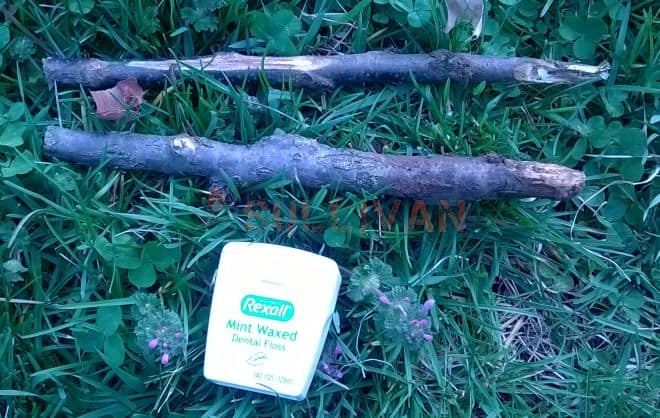
Step 2: Drive them in the ground a few inches shorter apart than the bow:

Step 3: Tie a loop on one end of the dental floss the desired size of the final loop in the bowstring. Loop that over one of the stakes in the ground and then go around the stakes several times with the floss.

The thickness needed of the bow string depends on the draw weight of the bow you have made. A bowstring for a hunting bow will probably need at least a dozen or so strands to withstand the weight of the bows draw.
If one strand held 5 pounds of dead weight, a dozen strands should theoretically withstand a 60 pound draw weight bow. I made this one 12 strands thick for a 30# bow.

A bowstring for a bow drill will probably be fine with just 6 or 8strands, I would braid them for a bow drill string.
Although if I were making a bow string for a bow that I needed to hunt with to get food, I personally would opt to over build it to make sure it doesn’t break. When you get to the final strand, tie it around the stick in a loop the same size as the first one you made.
Step #4: Now take the floss and come about 1 1/2″ from the end of your string and whip the bow string. Wrap each end with more floss for at least 1/2″ (an inch is better, depending on how much floss you have) to make a loop for the nock on the end of the bow.
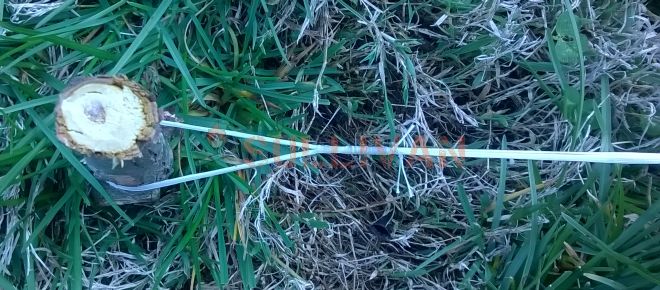
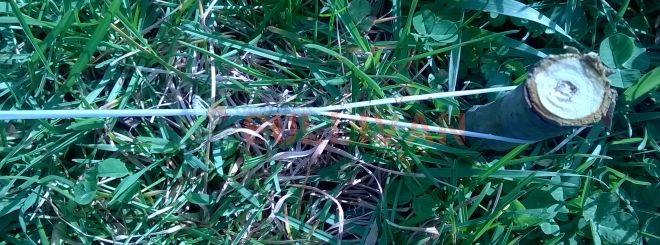
Step #5: Now find the center of the bow string and go two to four inches away from the center and wrap the bow string with floss all the way to two to four inches past the center.
This is called “serving” the bow string (although I’m not sure why it’s called that). This strengthens the bow string where you will have to nock the arrows and keep it from fraying and breaking.
Here’s a video showing a guy serving a bow string:
Here’s another video showing it done by hand:


Here I am testing the bow:
Bindings
Carrying on with the archery themed improvised uses for floss, the supple, flat and virtually weightless form factor of floss makes it perfect as a binding for fletching on arrows, ones that you bought or made.
Ask any seasoned archer, and they will tell you that minimizing drag and maximizing consistency and efficiency is absolutely vital when it comes to the shooting process, and this of course means your equipment.
Using floss as a binding for fletching makes it very easy to achieve a consistently thick, tight and concentric wrap when required.
Position the fletching so that the lashing also binds the nock (an arrow nock is the notch at the back of the arrow that goes on the string), to prevent the arrow shaft from splitting.
You can also lash the arrowhead to the shaft as well using dental floss. Using dental floss in this manner will make a very strong arrow.
Lashings
Floss is quite useful around the campsite as a general purpose lashing. It is strong enough and light enough, not to mention resistant enough to moisture and rot to be used for shelter creation, fashioning useful additions around the fire, hanging up gear and a multitude of other tasks.
The uses for floss in this way are limited only by your imagination. If it does have one shortcoming in this regard it is that it is so fine and thin that it can be quite difficult to unwrap it in order to reuse it for another task down the line, so consider using your flaws for any permanent or semi-permanent fixtures or creations you are crafting.
Handle wrap on tools and weapons
Most Preppers rely heavily on their tools for practice, for recreation and in the middle of a live survival situation. Axes and hatchets, knives, saws, shovels and many more.
All of these manual tools depend on the user to do work, and if you cannot keep your grip on a tool you might be setting yourself up for an accident at worse.
Once again, floss can help us out by increasing traction on tools that we need to hang on to tightly in the middle of high stress situations.
This naturally comes at the cost of increased friction and thusly a dramatically increased risk of blisters, so this is not appropriate for every tool, but for things like knives, hatchets and various weapons it is usually a good idea.
You can wrap a tool or weapon handle like you would perform any other various lashing, but make sure you have a good grip on the technique before attempting to improve the grip of your preferred weapon!
Trip Line
For setting up various traps, even if that is just an auditory booby trap alarm, floss works wonderfully as a trip or trigger wire. It is thin, strong and very low profile, all perfect attributes for this particular purpose.
Even better, it is very easy to discolor floss in order to better blend it into the surrounding environment simply by rubbing it in soil around the trap site.
One word of caution. Users should take care when employing floss as a trip line or manually activated trigger wire for any trap that will depend on a substantial amount of force for activation, sometimes the case for dead falls or other heavily loaded trap mechanisms.
Floss is strong but nowhere near as strong as paracord or other similar cordages, and so it could potentially break harmlessly without activating your trap!
Snare Line
Another good use for floss in a trap centric setting is as a snare line itself for small game. Floss is small, lightweight and delicate yet it can easily resist enough movement from its quarry to hold up until you can arrive to dispatch them.
This makes it ideal for use when you are after the smallest game that might otherwise scurry around and through larger, traditional snare wire or cord without activating the trap.
Do keep in mind that like all thin, lightweight cordage that your quarry can easily chew through the floss if they can reach it, so try and plan your capture accordingly and don’t rely on a floss snare wire to keep your captured prey held snug forever.
So long as you check on it in a timely fashion periodically you should be able to depend on it!
When making a snare line from dental floss I would strongly suggest that you use a braided strand.
A braided strand, while requiring more floss and time, will be much stronger and less likely to break should you get a five pound rabbit jumping and jerking on it before you get to him. Braid three strands of floss to make the needed length of cord for a snare, 2 feet is usually sufficient for a snare cord.
When you make a snare, tie one end to a sturdy stick that you will use to stake the snare to the ground. Tie a loop on the other end of the string to make the slip loop with.
Then find a couple of thin sticks with forks in them to use to hold the snare open in front of a rabbit hole or what have you. The snare/sticks can be reused multiple times.
Witness Line
One of my favorite uses for floss is as a witness line. Witness line is just a type of telltale marker, useful for determining if something has been disturbed, opened or moved in your absence.
Spies of yesteryear and today would often secure doors with a single hair discretely perched atop the door in the door jamb, secure enough that an errant draft wouldn’t blow it away but light and delicate enough that it would promise to fall free if anybody opened the door.
Floss is incredibly lightweight and easy to disturb, especially a small section of it, and so you can use it in the same way to discreetly secure your belongings and catch out potential thieves in your group or in the area.
The ways in which you can use floss for this purpose are virtually limitless. You can mark trails with it, doors, zippers and more, and only the most eagle-eyed and professional trespassers will notice it or even know what it means if they do.
Whip Rope
Floss makes a good whipping line for rope. No, I’m not talking about a whip as a tool or weapon.
Whipping line refers to small diameter cordage used on larger cordage, typically rope to prevent the ends from fraying into individual strands, greatly increasing the strength, dependability and usefulness of the rope. Think of it as a lashing for larger cordage and you are halfway there.
Using floss or any other cordage for whipping requires practice and a little bit of know-how but it is much easier than you might be thinking and this is an essential step to maximizing the useful service life of rope or any other stout cordage.
To keep your rope from unravelling you can tie the ends with floss, this is called whipping the rope. You can see by the pictures it isn’t hard to do. Just run the floss along the last inch and then wrap it back over itself.
Then when you have enough of the end wrapped all you have to do then is just tie the loose ends off. Cut off the frayed ends of the rope and you’re done:
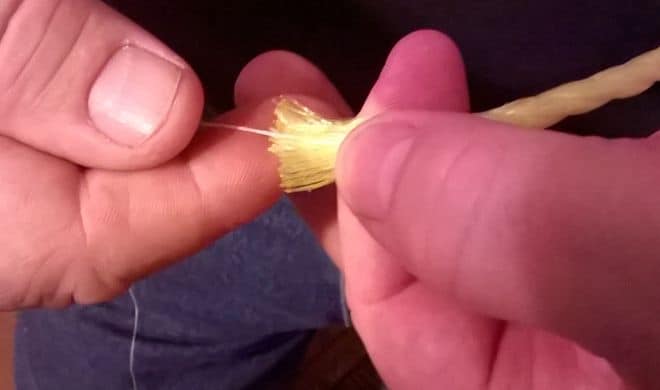
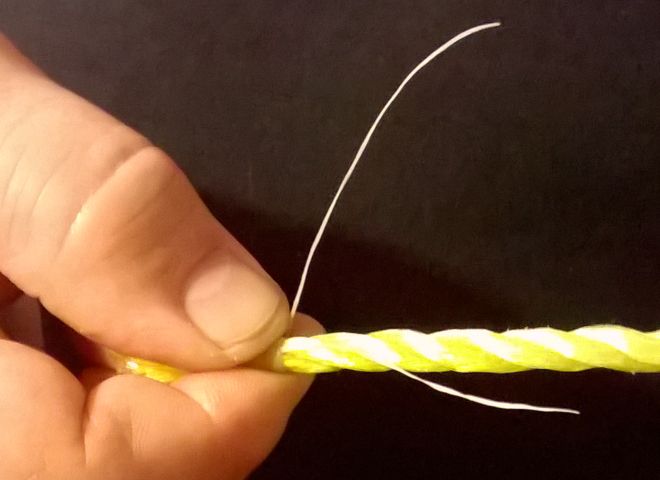
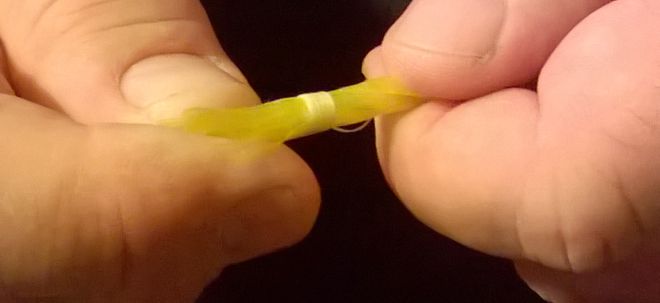
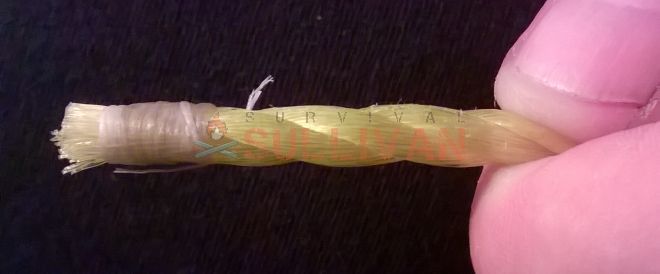
Practice makes perfect, and every prepper should know how to implement this vital step in taking care of their tools.
Making a net
For those who have the skill, floss is just about as perfect a material as you can get for making a small, fine net perfect for capturing delicate game on land or in the water. It is lightweight, strong and, in the water, nearly invisible, allowing you to use it as a casted capture net or a gill net for corralling and then subduing fish.
Note that making a useful, reusable and dependable net is anything but easy and definitely requires practice but so long as you have the skills or a good, grounded working knowledge of net making you might find that floss is perfect when you are after smaller quarry.
Obviously it has some drawbacks, namely the fact that individual strands are so light and delicate they are prone to tangling or breaking but in the right application this is a small concern.
Repair eye glasses
An excellent use for floss as an improvised method of repair for glasses, be they sunglasses or prescription lenses.
It always seems like those itty bitty, incredibly tiny screws come loose and invariably disappear when we can least afford to be without our eye pro or our spectacles. It is bad enough trying to track it down inside our own homes but if you are outdoors, anywhere outdoors, forget about it!
Once again floss comes to our rescue. Out of all the various cordages that you might use, only floss is thin enough, delicate enough and strong enough to be threaded through that equally tiny screw hole holding the temple of our glasses to the frame and then lash down tightly to secure it in place usably. It might not be perfect, but it will definitely hold until you can affect a more permanent repair.
For flossing your teeth!
Just because you’re lost doesn’t mean you can forgo proper hygiene. It might seem like I am cheating a little bit here because this article is about the survival uses of floss and here I am talking about its mundane, everyday use. I’m including this entry for a very specific reason, however.
Continuing to take care of yourself, and that includes taking care of your body, is still important during a survival situation, but most especially during a long-term.
Deferring self-care and particularly care of your mouth and teeth is a recipe for disaster because oral maladies can quickly become showstoppers. Pain from a bad cavity or, worse, an abscessed tooth can be borderline crippling and keep you from eating or drinking.
Avoid such an unhappy fate and a survival situation by taking care of your teeth the same way you always do! That means brushing and flossing daily.
Wrapping it Up (With Floss)
Well, again, like I always say, if you should find yourself in a survival situation you must be able to think outside the box, and utilize the materials at your disposal to achieve many things.
If one of the materials you have happens to be dental floss you can actually accomplish a great deal with it. But do try to save a bit to actually floss with.
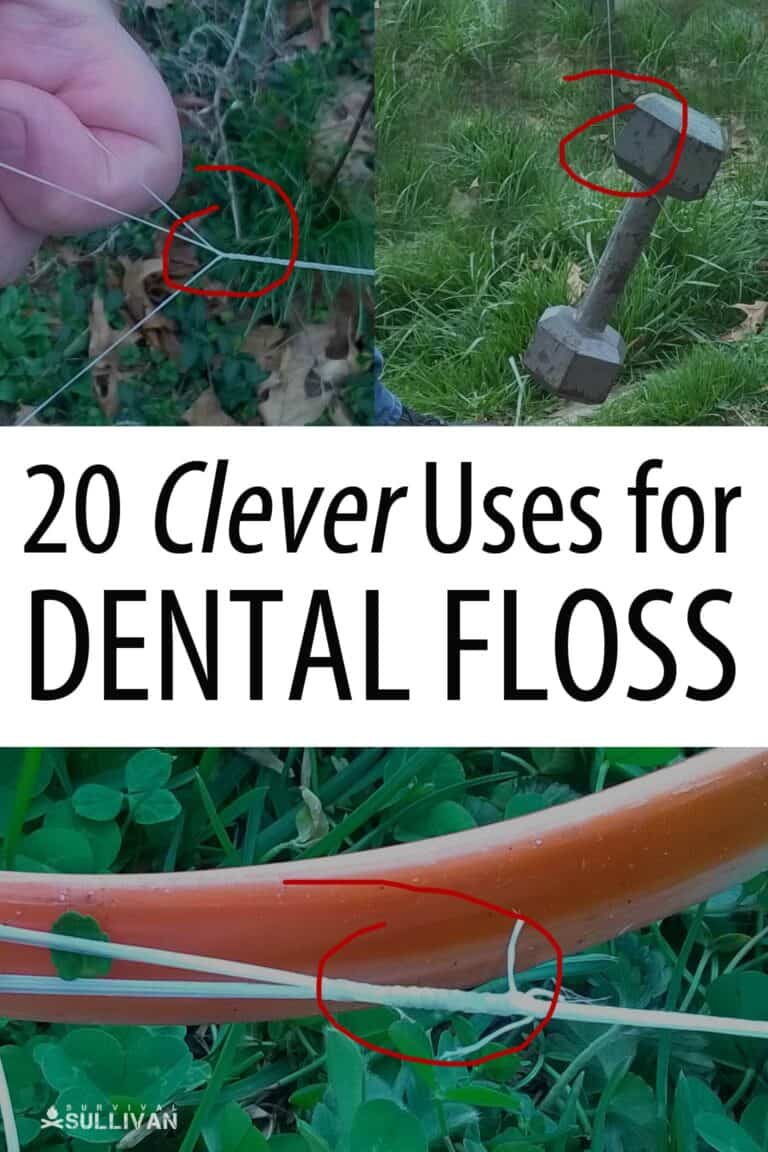

Eric Eichenberger is an avid outdoorsman, skilled marksman, and former certified range officer and instructor with nearly 40 years experience handling and repairing firearms.
A skilled craftsman with a strong love for working with his hands, Eric spent 20 years as a carpenter and custom woodworker in high end homes. As a gold and silversmith he has created hundreds of pieces of jewelry over the years using the lost wax casting method.
The grandson of humble country folk, he was raised with the “do it yourself” mentality and so is accustomed to coming up with unique solutions to problems utilizing materials at hand.

Great info. If I could just add this https://www.amazon.com/FLOSSCARD-Dental-Credit-Shaped-Dispenser/dp/B00AEVP8QG/ref=sr_1_3_a_it?ie=UTF8&qid=1486382633&sr=8-3&keywords=floss+card as a convenient way to carry floss in your wallet or person.
Cool, thanks for the info!
Quite off survival, but I remember that strippers in bars used dental floss to tie their G-strings because it wouldn’t break under lustful audience members grabs!
Now thats a great use, Charlie!
Yes Charlie, that is quite off topic. I wouldn’t know anything about bars or strippers as I try to invest my short time here on Earth for better endeavors. But I can imagine that if a stripper were to lose her g string that it would most likely be an unpleasant sight. Thanks for reading and taking the time to leave your off topic, off color comment. Although I suppose that use could be viewed as survival in a way, as the stripper is trying to survive being disrobed.
Eric
I used it last week to make an E string for my violin and it was wonderful with full sonority great strength